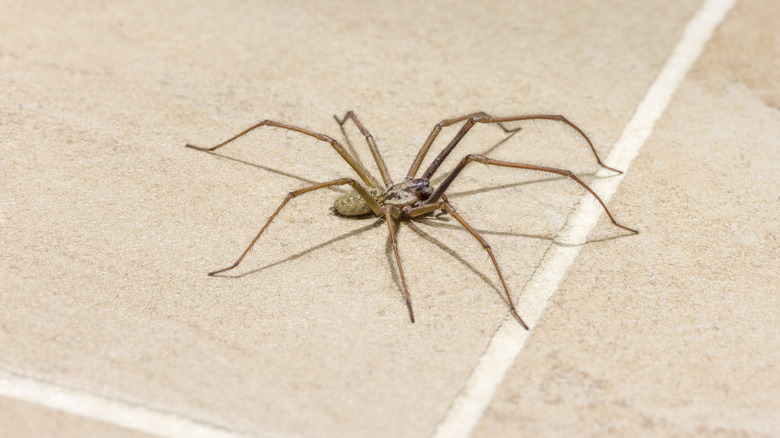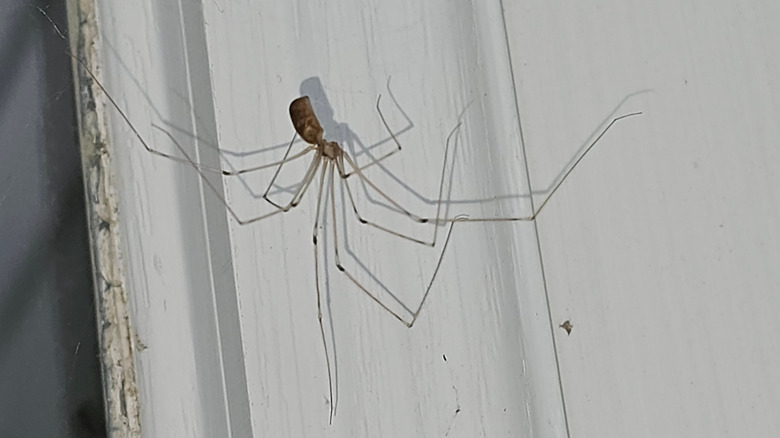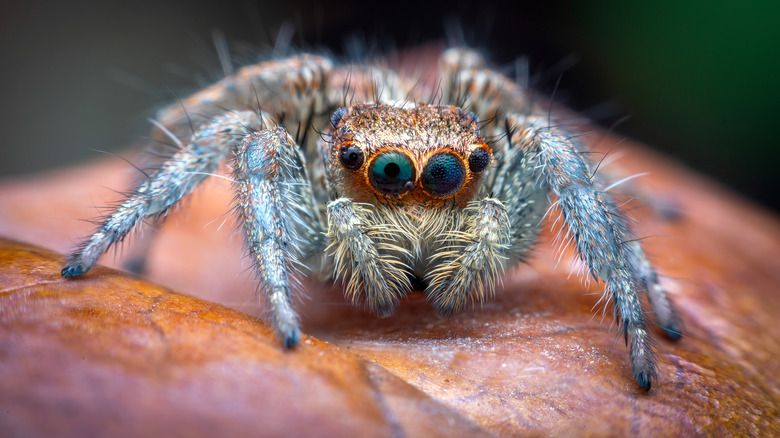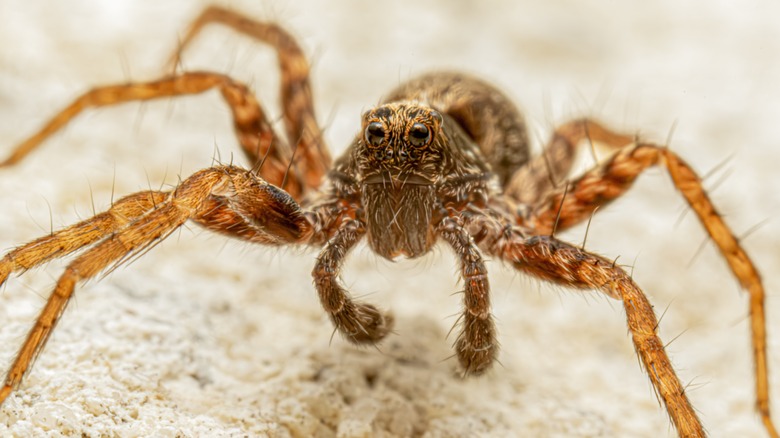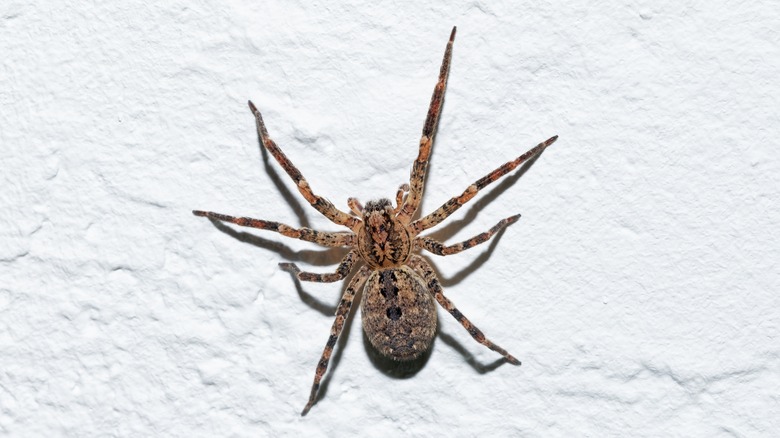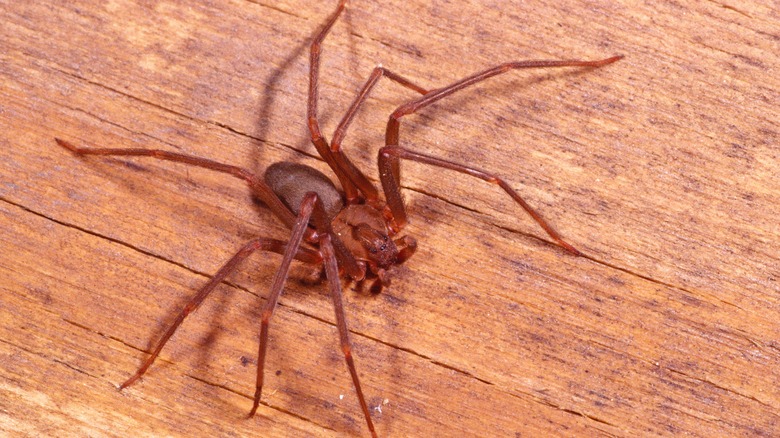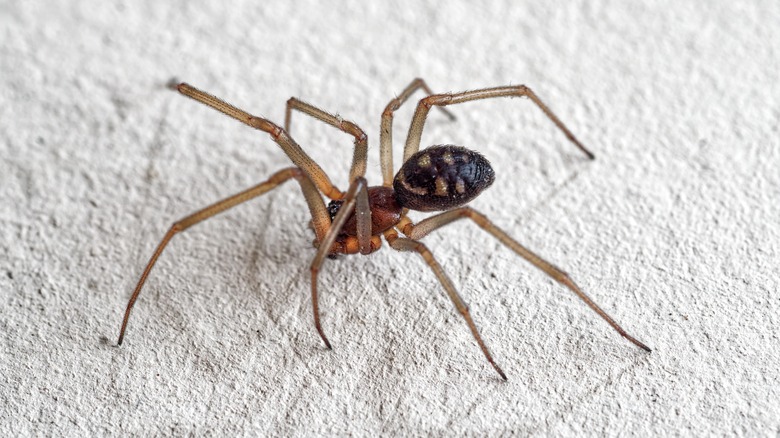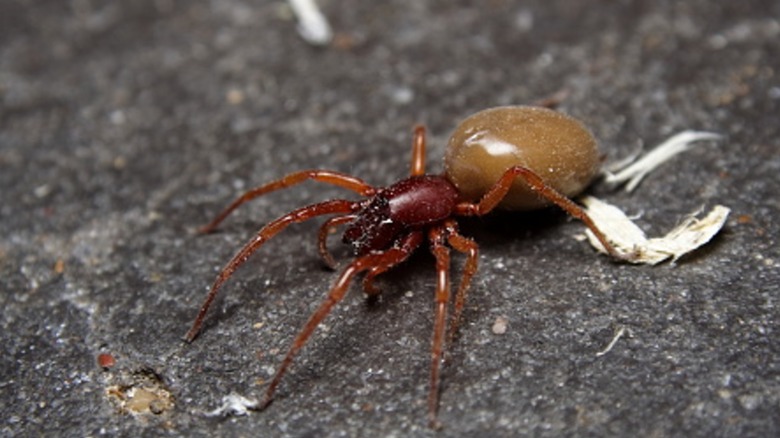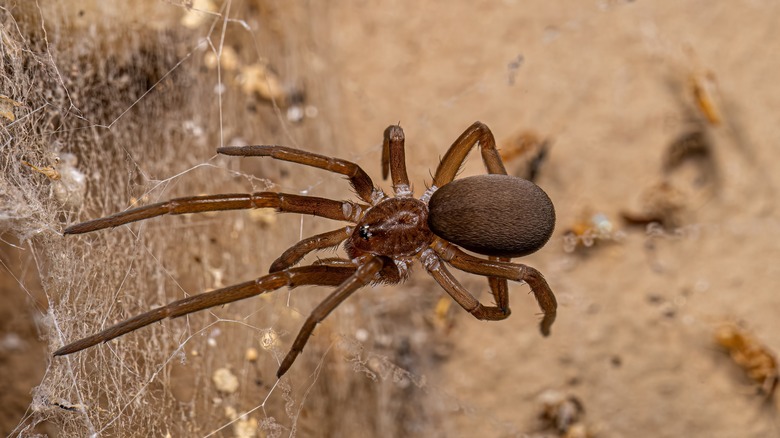The Top 10 Most Common Spiders You May See In Your Home And What To Do About It
Imagine feeling excited about wearing that beautiful dress you stored away for a special occasion. But when you take it out, a spider jumps out. How upsetting! With over 2500 species found in North America alone, it's no surprise that some mistake our homes for their shelter. Common house, cellar, yellow sac, false black widow, and southern house spiders are a few examples. Others, like wolf, hobo, brown recluse, jumping, and woodlouse hunter spiders, sometimes wander inside while looking for mates or prey, especially in wooded areas.
Luckily, not all of them are dangerous. To be fair, it's mostly the brown recluse (and black widow) that you must fear, given their highly venomous bites. The rest can often be tolerated in small numbers if they keep to themselves. They'll also help keep the population of termites, carpenter ants, house flies, and roaches in check — sans pesticides. However, if they creep you out or you find their webbing an abject nuisance and wish to eliminate them, take a few precautions. Stay gloved while removing spiders, and save their carcasses in case you're bitten and need medical care. To minimize webbing, switch porch lights to yellows or cool LEDs so your home doesn't attract many insects or their hunters (read: spiders). With the basics established, let's discover the common spiders invading your home, the dangers they pose, and when and how to remove them.
Homeowners across the country encounter common house spiders regularly
Common house spiders (Parasteatoda tepidariorum) and their tangled mass of silken cobwebs require little introduction. After all, they're quite common across the contiguous U.S. Although their looks can vary — this spider family has over 230 species — they all look drab, with their under ¼ inch bodies sporting white, tan, or yellow hues. Their abdomens are quite high, rather than long, and are mottled white, while the lower ends of their legs are riddled with stiff hair. Moreover, their body joints are marked in dark rings. While you may mistake their males for brown recluse, house spiders stick to their webs at all times (unlike their lookalikes). If in doubt, use BugGuide for a better ID.
You might want to keep American house spiders around. They usually set up shop (webs in this case) where common household pests, such as mosquitoes, cockroaches, and flies, socialize. Think areas like window panes, high corners, damp basements, garage doors, or underneath furniture. They may even get rid of willful intruders, such as wasps, clothes moths, and lizards. Plus, they won't chase you down or bite you unless they feel threatened. If they do bite, you'll feel the pain for a day (maximum), unless you're allergic. But if you'd still like to eradicate them, vacuum their webs, especially in the summer when they're actively reproducing. Since they tend to loosen dead insects right underneath their webs, follow the trail to spot their harbor.
Cellar spiders are extremely common in damp, crawl spaces year-round
Cellar spiders (Pholcus spp.), especially long-bodied cellar spiders, regularly invade homes across the country, no matter the season. They come across as highly undernourished brown recluse spiders, with their lean, brown (or gray) bodies clad in stretched-out, spindly legs. Their long legs have earned them the moniker daddylong-legs spiders, though they aren't the same as the harvestmen, which aren't even spiders. They're usually tiny, no more than ⅓ inch, and may at times show dark rings on their leg joints (appearing knobby-kneed).
Cellar spiders are generally harmless and have little zeal or implements (thanks to tiny mouthparts) in biting us humans. So, it's better to tolerate their presence. Luckily, they stick to dim, secluded cellars (duh!), crawl spaces, staircases, and basements throughout their time and are barely noticeable. In the rare instances of a bite, the pain goes away within a day or so. Plus, these uninvited house guests readily prey on disease-causing mosquitoes, gnats, crane flies, or wolf spiders. As cellar spiders can cannibalize on their brethren when food supplies run low, you won't have to worry about their population growing out of control. Still, if an odd one braves the light, suck it up with a vacuum; trying to capture it can lead to its head detaching from its delicate legs. If you're sick of their ugly, yet non-sticky webs, knock those down with a broom. Ventilate or dehumidify the area to discourage their target insects from entering indoors.
Jumping spiders are commonly seen scaling walls, ceilings, and windowsills across American homes
Unlike house and cellar spiders, jumping spiders (Salticidae) are not comfortable staying inside human settlements. Yet, they often stray indoors while chasing down prey or searching for it when food is scarce outside. They might also drop by when looking to hunker down in a warmer spot for the winter. Visually, jumping spiders feature dime-sized, white-marked bodies that, depending on the location, may be black, brown, or gray. They've short legs, but can jump way higher and crawl around in a jittery motion. Their standout feature is the large pair of eyes in the middle of their head.
Since jumping spiders are blessed with excellent vision, they'd rather flee than venture closer to bite or harm you. But if you distress them, their bite is akin to a mosquito's bite, unless you're allergic to spider venom. If the pain persists beyond a day, seek medical attention. As for dealing with them, look for the warning signs of a jumping spider infestation. This could be mostly catching the arachnid in motion in sunlit windows, walls, doors, or ceilings where insects tend to congregate. You may also find them or their collection of web retreats, wrapped in draperies, around window moldings, under doors, or furniture. Try to capture them by covering them with a jar and sliding a cardboard sheet underneath to easily release them in the garden, where they'll feed on harmful pests. If not, a vacuum works, too. Airtight the seals on doors and windows to keep them from wandering in.
Wolf spiders often wander indoors while hunting and are commonly seen throughout the U.S. during the fall
Similar to jumping spiders, wolf spiders (Lycosidae) are more at home outdoors than indoors. Yet, they can become a common sight inside basements, windows, doors, wardrobes, or houseplants, during fall when they're seeking a warm, overwintering habitat. Other times, they foray inside when they're chasing down food. They're also common in new constructions, where all the building activity displaces them from their homes. However, identifying them can be tricky. Wolf spiders exhibit a wide variety in terms of size, color, and patterns. Adults can be as small as ½ inch, while the bigger specimens can grow over 2 inches and can inspire fear. These hairy-legged creatures are colored brown, black, or gray with striped or spotted patterns for contrast.
Regarding danger, wolf spiders are shy and won't bite even if they run over your hand. However, if you try to squish them down, pinch, or mishandle them, the bigger spiders won't think twice before pricking your skin. The wound usually doesn't require any medical attention and heals in a day. Since wolf spiders wander inside while hunting, they don't usually persist indoors for long and leave on their own accord within a day. Plus, even though it's the pregnant adult spiders who overwinter inside, there's little risk of infestation since spiderlings emerge well after spring. If you'd like to cover all bases, the best way to get rid of wolf spiders in the house is to capture them with a glass jar and remove them outside for pest control. Seal any gaps to discourage re-entry.
Yellow sac spiders are found nationwide and are most active at night
Prevalent across the Northern Hemisphere, yellow sac spiders are another arthropod species that is common both inside and outside homes. Of them, you're most likely to find Cheiracanthium mildei — an introduced European species — year-round since it prefers living and reproducing inside. These ¼-inch long, pale-bodied individuals have a dark strip running through their green-tinged abdomen (near their heart). Contrastingly, C. inclusum, which is native to the U.S., has a creamish-yellow body and forays indoors during fall to spend the cool months, then leaves when it's warm outside. Both have long legs that terminate in a dark tuft of hair.
Though they offer biological control by feeding on flies and larvae, yellow sac spiders are considered a biting pest. Although spider bites — for any spider variety — are rare, when they do happen, the blame usually falls on yellow sac spiders. This can be partly attributed to them getting caught in between sheets and biting humans in their sleep, though they'll bite even when not provoked. Luckily, though, the pain is on a similar scale to a bee sting and doesn't cause any necrosis, unless you're allergic.
Since yellow sac spiders are night hunters and live inside their web retreats during the day, banish them by vacuuming them and their homes. Look for light-toned silk sacs where walls meet ceilings, crown moldings, wall hangings, drapes, and doors. Until they're entirely removed, move your beds at least 8 inches away from the wall and keep bed skirts off to minimize the risk of bites.
Hobo spiders frequent basements in Pacific Northwest homes
If you live in the Pacific Northwest, specifically in the area running between British Columbia and Utah, with Colorado marking the eastern end of the range, you may have to grapple with hobo spiders (Eratigena agrestis). They are common during late summer to fall (August to October), when males are looking for partners to mate with, although occasional spring sightings aren't off the menu. Their offspring overwinter indoors and may remain inside for nearly two years until they become adults. Hobo spiders can be about ½ inch long with their earthy brown bodies marked in white spots. However, as they look eerily similar to many other funnel-web spiders, identifying them with 100% certainty isn't possible for non-experts. You may have some luck writing off similar-looking spiders and concluding if the invading pest is a hobo with a hand-held microscope.
Hobo spiders and their look-alikes prefer scurrying away for cover, rather than attacking humans. Plus, they're nocturnal hunters, so it isn't likely that you'll spot them. However, they can bite if touched, possibly riddling you with pain and a headache that may last a week. While claims insinuating they cause necrosis have been debunked, it's still ideal to treat them as pests. They may be tolerated in small numbers around basements. But if they wander into wet areas like bathrooms, make use of sticky traps to get rid of hobo spiders. They can't climb textured surfaces, but if you keep bedding, clothes, or shoes on the ground, they may shelter inside them.
Brown recluse spiders inhabit undisturbed spots in homes located in the Midwest and south-central U.S.
The brown recluse spider (Loxosceles reclusa) is one of the most misidentified and pain-causing species. However, its presence in your home is a concern only if you live in the south-central or Midwest region (check the official range map here). Brown recluse spiders are easily identifiable by the fiddleback or violin shape present on their abdomen. Six eyes separated into three pairs, arranged in a semi-circle, are another distinguishable feature, as are the hairy, long legs sprawling out from their ½-inch long, tan bodies.
As their name suggests, brown recluse spiders are solitary and keep to themselves in dark, damp, undisturbed spots in and around basements, cellars, storage areas, and attics. However, they may amble inside living spaces, such as bathrooms or living rooms, while hunting and can pose a significant threat. If pinched, deliberately or otherwise, brown recluse spiders can bite. Depending on the person, the pain may either become immediately apparent or take over three hours to fester. It's eventually followed by painful blisters that require grafting for recovery and can prove fatal in rare cases. Given such risks, it's best to eliminate any brown recluse spiders invading your home. If you notice the spider, any shed skins, or a hodgepodge mass of off-white sacs, install sticky traps to determine the level of infestation. Baseboards, ducts, suspended ceilings, and ground clutter are ideal hotspots. Upon confirmation, employ these simple brown recluse pest control hacks, or call in the pros.
False black widow spiders are common in coastal states throughout the year
Unlike the much derided black widow spiders that rarely enter indoors, their doppelgangers, false black widows (Steatoda grossa), have no such qualms. In fact, they relish the interior warmth and moisture. These European introductions are limited in their spread, mostly concentrated in the coastal states of the Pacific Northwest, Gulf, and the Atlantic, with rare occurrences around Alaska. To differentiate the two, focus on the hourglass pattern, which is mostly missing or oval-esque, versus the true black widow. Otherwise, they're similar in size at ⅜ inch, with yellowish-gray markings all over their bulbous purplish-black bodies.
Despite the uncanny similarity, false black widow's venom isn't as toxic. While they can overpower true black widows, their bite isn't fatal to humans. Instead, symptoms mostly include severe pain, the kind you experience from yellow jackets, nausea, headaches, and blisters.
Apart from physically encountering these spiders below furniture, in wet areas, or cupboards, another sign of their infestation is the presence of webs, often peppered with egg sacs. These webs or sacs appear as a messy tangle of cotton balls that've been discarded willy-nilly. They're usually found in underutilized places, such as crawlspaces, garages, and cabinets, either on the floor or near beams. Either vacuum them and their webs, use sticky traps, or squish them underfoot at night for control. But they multiply rapidly, so eliminate them regularly for full eradication. Pyrethroid-based insecticides may be used as a last resort.
Woodlouse hunter spiders frequently enter U.S. homes looking for prey
Another European import, the woodlouse hunter or sowbug spider (Dysdera crocata), can become a cause of concern if it drifts inside homes during hunting. The reason? Their appearance. At over ½ inch, woodlouse hunter spiders are quite large with formidable fangs. These eight-legged creatures have six eyes set in the shape of a downward-facing arch. Their abdomen is a subdued gray, though the orange legs create a distinct contrast. Combined, such features make it easy to identify sowbug spiders. Their spread is heavily concentrated west of the Cascade range, though they've since outspread throughout the continental states.
Despite their intimidating appearance, woodlouse hunter spiders don't carry much bite. Although it can be inconvenient if they step on your face while you're trying to sleep, their bite isn't toxic. The pain usually lasts two hours and is mostly the aftereffect of having been pierced by big fangs — hence, the itchiness — and not the venom.
Still, if you spot them roaming inside, capture these arachnids with a glass jar and release them outside in the garden. They're more useful out there since they quickly make meals of sowbugs, pillbugs, or other hard-bodied insects that target your precious plants. Additionally, check the mulch, debris, rocks, logs, or firewood touching your home's foundation for any woodlice infestation, especially if they're damp, and replace them. Add door sweeps and weatherstripping to windows to barricade their entry.
Southern house spiders are common to southern states
The southern crevice or house spider (Kukulcania hibernalis) is mainly found in southern states, particularly Florida. Male and female spiders can look quite different, with the former often confused for brown recluse spiders, even though they lack the characteristic violin mark and have eight, rather than six, eyes. Per usual, the males are smaller in size, at 10 millimeters, but feature a brown strip running across their amber-colored bodies. In contrast, female southern house spiders are bigger at 19 millimeters and are shaded a dark brown.
Southern house spiders can bite, although the pain vanishes in a couple of hours. These arachnids have a thing for deep, recessed crevices, like the crannies around window shutters or overhangs. Basically, sites homeowners overlook. Therein, they knit their woolly webs that are intrinsically woven to entangle any insect that may stray inside. Nests on walls, ceilings, or under baseboards are also common. Since the webs can grow unkempt with the insect discards, clear them off with a broom or a vacuum. With house flies, roaches, beetles, and mud dauber wasps as their prey, southern house spiders offer cheap pest control services. But if they're unwelcome in your home, scoot them out or trap the male spiders in a glass vial. However, you can capture their female counterparts only at night when they step out of the crevice and perch on their web. Keep vacuuming these spots to get the population of indoor pests and, by extension, these spiders under control, and seal any significant holes in exterior walls.
